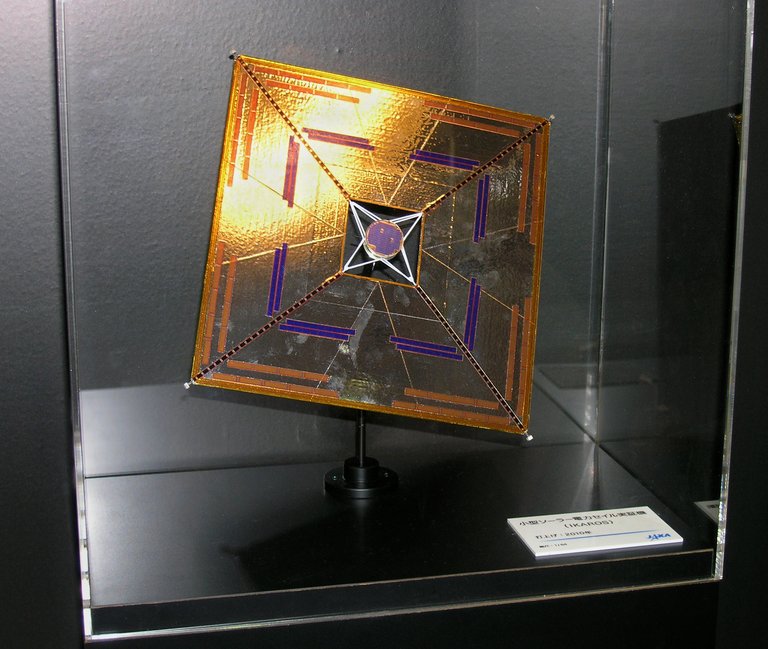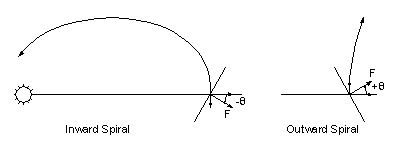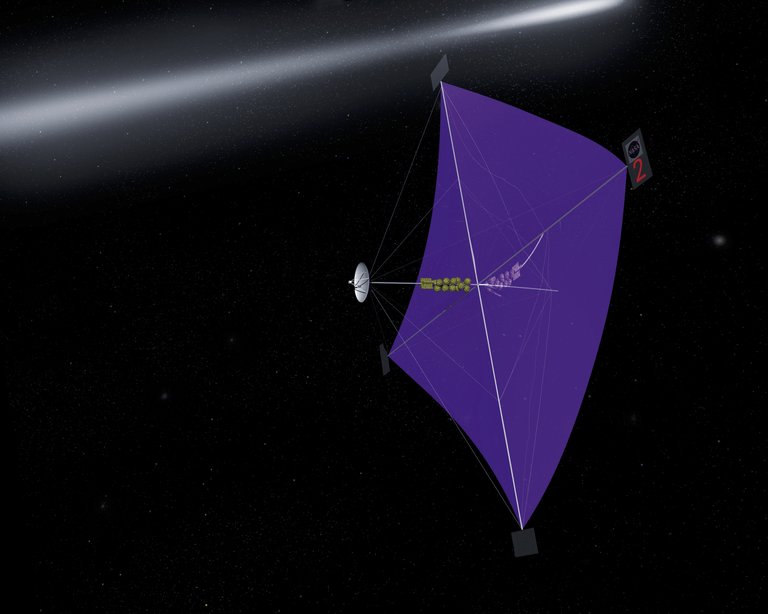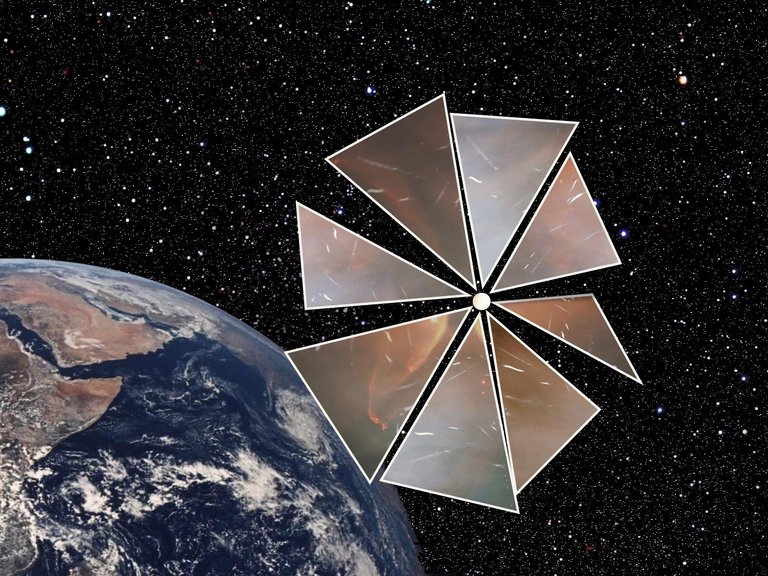
The IKAROS
Last time we talked about how solar sails worked. Today let's dive into more detail about current, and future, solar sail technology.
Above is a 1:64 scale model of the IKAROS solar sail spacecraft. Somewhere out in the solar system, stuck in an orbit around the sun nearly 200,000,000 miles away, the actual IKAROS spacecraft is floating in space. The ship got there, in part, by using solar radiation. The Japanese Aerospace Exploration Agency launched IKAROS in May 2010. By 2014, the IKAROS craft had gained 400 meters per second in speed exclusively from radiation pressure.
The IKAROS was designed to reflect as much solar radiation as possible because as we discussed last time, reflection of a photon creates the most radiation pressure. With this in mind, the design of the IKAROS sail aimed for 100% efficienct reflection. Present material sciences don't allow for perfect reflectivity, and so a great solar sail would be maybe 90% reflective.
Although the reflective surface gained a lot of speed out in space, it doesn't create anywhere near enough propulsion to get a solar sail into space in the first place.
The IKAROS was launched into space with conventional rocket propulsion. Then, when it reached outer space, the sail was unfurled by spinning the IKAROS probe, slowly swinging the sail out to full extension. Once unfurled, the sail began reflecting solar radiation and accelerating under radiation pressure.
Navigating With A Solar Sail
A solar sail needs to be oriented to best capture solar radiation at all times, while still maintaining the ship's course. To achieve this the IKAROS uses a ring of LCDs around its edge which can change reflectivity on command.
Making a portion of the LCDs more or less reflective allows the IKAROS to steer itself. Do you understand how?
By making one side of LCDs less reflective, it means that side absorbs more solar radiation. Absorption results in less radiation pressure than reflection, and therefore less propulsion on that side of the probe.
So, if you leave the right side LCDs very reflective and make the left side less reflective, then you end up with one side of the ship being pushed harder than the other side. The result is, slowly but surely, the ship will turn!
By ringing the IKAROS in these changeable LCDs, its designers built in a surprising amount of mobility into the ship, which allowed it to make minute course changes using solar radiation alone.

By changing the angle of the sail, the ship can be sent into spirals which alters the ships course. However, beyond just navigation, the ability to constantly adjust the IKAROS solar sail also ensured the IKAROS was able to consistently reflect enough solar radiation to speed up its journey to Venus significantly.
This is an amazing milestone in space propulsion, but it isn't quite interstellar travel. The question is, where do we go from here?
Scaling Up Solar Sail Technology

As with all things, part of the solution is sheer scale. The IKAROS sail was 46ft by 46ft (14m by 14m). This is pretty big, but nowhere near as big as an interstellar sail would need to be. The larger the sail, the more solar radiation it will capture and reflect, and the lighter the sail, the less radiation pressure it will take to accelerate it.
The goal in designing an interstellar capable solar sail would be to make the sail as large and reflective as possible while minimizing the weight as much as possible. These two photos represent theoretical designs for future solar sails, which could be kilometers wide.

The problem for interstellar travel is that the size of the sail is not going to be enough. The farther away you get from the Sun, the less powerful its solar radiation becomes. One way to compensate for this is to make the sail larger, but eventually you will either have a sail that's too distant from the sun, or simply too large, with too much mass, to continue accelerating under the force of solar radiation energy alone.
So how do we get to other solar systems using a solar sail?

One option is to replace the diffused solar radiation with something a bit more direct: A good ole super laser!
The picture to the right is just illustrative of the idea - it is not an actual super laser - at least, not of the size and energy we'd need. Still, the concept is pretty straightforward: unfurl a solar sail in space and fire a super powered laser right at the sail. Although it may sound very different, this is really just an extension of the ideas we already talked about.
Even the high powered beam of a super laser is just photons all hyped up with energy and momentum. By shooting the laser at the solar sail, assuming everything went as planned, it would be like a nitro boost for a race car. The solar sail ship would fly forward through space, accelerating much more quickly then by solar radiation alone.
Unfortunately, the super laser presents major problems. First, the laser would actually have to be super powerful - more powerful then any laser ever made, in order to get the sail up to the speeds necessary for realistic interstellar travel. Second the laser would have to be kept on, firing continuously for years at a time, which would be a major engineering challenge.
Focus On The Positive
The fact is, we have no realistic or immediate way of using a solar sail to go to Alpha Centauri. However, not only do we have concrete plans to use solar sails in our own solar system, we've already done so! Since a solar sail uses no propellant except for the initial launch rocket and the sun's radiation, there are major financial benefits in the maturation of this technology for subluminal travel inside our solar system. Whether we'll ever reach the stars on a solar sail is less likely.
But, dammit, humanity is determined to try to get the hell out of here. So far we've been moving from the most outlandish possible means of interstellar travel down towards more conceivable methods. Solar Sails were the first technology which exists today, but interstellar travel is going to be tough using them alone.
Next time we deal with something that not only exists right now, but might have a decent shot at interstellar travel, at least with unmanned probes: Ion Engines.
Information Sources
https://en.wikipedia.org/wiki/Solar_sail
https://en.wikipedia.org/wiki/Photon
https://en.wikipedia.org/wiki/Radiation_pressure
https://en.wikipedia.org/wiki/Solar_irradiance
https://en.wikipedia.org/wiki/Solar_wind
https://en.wikipedia.org/wiki/IKAROS
http://global.jaxa.jp/projects/sat/ikaros/index.html
Photo Sources
[1]Pavel Hrdlička, Wikipedia CC BY-SA 3.0, via Wikimedia Commons
[2]By Jerry Wright Own work CC BY-SA 3.0, via Wikimedia Commons
[3]By NASA/Marshall Space Flight Center Public domain, via Wikimedia Commons
[4]By John Ballentine CC BY-SA 4.0-3.0-2.5-2.0-1.0, via Wikimedia Commons
[5]By ESO/Y. Beletsky CC BY 4.0, via Wikimedia Commons
Check Out My Other Posts:
The Amatuer Mycologist - Chicken Of The Woods and The Porcini
Piqued #7 - Solar Sails Part I
Also check out my awesome Marvel Coffee Table
Upvoted and Resteemed by the xx_Votes_Plus curation trail! Want more earnings? Follow @dropahead in Streemian https://streemian.com/profile/curationtrail/trailing/396 and/or delegate some STEEM POWER to @dropahead! Keep up the good work!
Amazing post. keep it up.
Thank you very much! Much appreciated
This remembers me the alien:covenant movie that I just watch yesterday...
This post received a 1.2% upvote from @randowhale thanks to @dber! For more information, click here!
@dber got you a $27.0 @minnowbooster upgoat, nice! (Image: pixabay.com)
Want a boost? Click here to read more!
Hey @minnowbooster
So this comment say a 27$ upvote -
But the actual value barely broke 10$
And that's for a 9SBD payment.
Not sure what happened.
There was a display bug the 27 would be at 100% voting power
Never really heard about solar sails before, thank you for your info!!
Awesome technology - but unlikely to guide us to interstellar space
wow, I love reading on about stuff like this!
Well we've got at least two more theoretical soace engines to cover before i move away from interstellar flight - one of them is - pardon
ooo!
Travelling to other solar systems is still a long way from happening. Great post! Keep them coming.
Quite a ways away unfortunately - that hasn't stopped this whole series from spiraling down the hypothetical rabbit hole